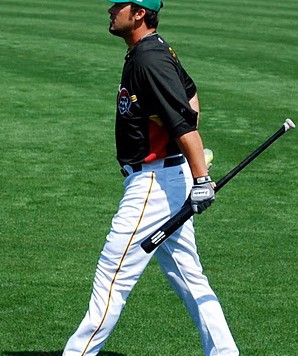I’ve been saying for some time now that it wouldn’t be fair to evaluated Garrett Jones until he’d played a full year for the Pirates. Guess what? July 1st marks the official one-year Jones-iversary. He’s played in 159 games in the last 365 days, so I think it’s fair to start taking a longer look at just what type of player Jones is.
Here are Jones’ stats with the Pirates so far:
| Year | Age | Tm | Lg | G | PA | AB | R | H | 2B | 3B | HR | RBI | SB | CS | BB | SO | BA | OBP | SLG | OPS | OPS+ | HBP | IBB |
|---|---|---|---|---|---|---|---|---|---|---|---|---|---|---|---|---|---|---|---|---|---|---|---|
| PIT (2 yrs) | 159 | 681 | 599 | 78 | 173 | 38 | 1 | 31 | 91 | 16 | 5 | 73 | 133 | .289 | .364 | .511 | .875 | 133 | 2 | 9 | |||
That’s a good year. Seventy extra base hits, a walk rate above 10%, an acceptable strikeout rate, that’s all good stuff. It’s not Jason Bay in his prime, but he’s definitely an every day player. Given the way he was acquired, having this guy on your team is pretty much striking gold.
Now let’s look at each year separated:
| Year | Age | Tm | Lg | G | PA | AB | R | H | 2B | 3B | HR | RBI | SB | CS | BB | SO | BA | OBP | SLG | OPS | OPS+ | TB | HBP | IBB |
|---|---|---|---|---|---|---|---|---|---|---|---|---|---|---|---|---|---|---|---|---|---|---|---|---|
| 2009 | 28 | PIT | NL | 82 | 358 | 314 | 45 | 92 | 21 | 1 | 21 | 44 | 10 | 2 | 40 | 76 | .293 | .372 | .567 | .938 | 147 | 178 | 1 | 8 |
| 2010 | 29 | PIT | NL | 77 | 323 | 285 | 33 | 81 | 17 | 0 | 10 | 47 | 6 | 3 | 33 | 57 | .284 | .356 | .449 | .805 | 118 | 128 | 1 | 1 |
 Only the home run gap stands out, but Jones is just a little behind last year’s pace in just about every stat column this year except for strikeouts (and RBIs, but I don’t care about those). Jones has by no means been bad this season, but he hasn’t been great either. Put in simpler terms, the 2009 Garrett Jones is an All-Star, 2009/2010 combined Garrett Jones is a solid starter on a good team, and 2010 Garrett Jones is a marginal starter at first base or in a corner outfield spot on teams on pace to score more than 519 runs.
Only the home run gap stands out, but Jones is just a little behind last year’s pace in just about every stat column this year except for strikeouts (and RBIs, but I don’t care about those). Jones has by no means been bad this season, but he hasn’t been great either. Put in simpler terms, the 2009 Garrett Jones is an All-Star, 2009/2010 combined Garrett Jones is a solid starter on a good team, and 2010 Garrett Jones is a marginal starter at first base or in a corner outfield spot on teams on pace to score more than 519 runs.
FanGraphs carries a stat called wOBA that was first created by Tom Tango in his The Book. What it does, in essence, is combine slugging percentage with on-base percentage in a much more effective manner than OPS does, because OPS significantly overvalues SLG and undervalues OBP (this post at FanGraphs about it may be a little more digestible). It’s then scaled to the league OBP so that an average wOBA equals the average OBP in any given year. That means you can think of it in the same terms as OBP; .400 is a great wOBA, .350 is decent, below about .330 is below average. Jones’ wOBA was .396 last year, it’s just .354 this year.
What all this means is that we have a new question to ask ourselves about Garrett Jones. We no longer have to worry about him turning into a pumpkin at midnight. It seems to me that he’s obviously progressed beyond the guy that took forever to get out of Triple-A and he’s a big league hitter now. The question is if he’s a marginal starter or an every day player. The good news is that while he got off to a slow start this year (despite his three homers in the first two games, his OPS was .731 in April and .771 in May), he absolutely killed the ball in June (.330/.389/.516 despite only four homers).
Obviously he won’t hit .330 every month (his BABIP was .373 in June compared to .323 last year), but he’s definitely heating up a bit. He did the same thing last year, hitting nine more home runs with the Pirates than he did in the first half of the season with Indianapolis. If he can do that again this year, we’ll have to re-adjust expectations for him accordingly.
Which means that even after a full season in the big leagues, Jones is still a bit of an enigma. We know a whole lot more about him as a hitter than we did last July when he showed up in Pittsburgh and started launching baseballs into the stands, but there are still some questions left to be answered.
Picture by: Me!




















